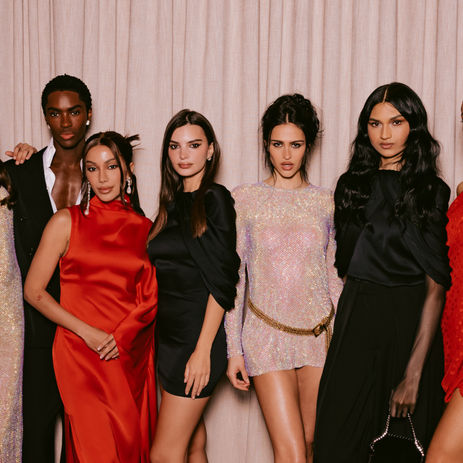Maximalism Is Not Always Fashion Forward and That’s Okay
- BY MAMELLO MOKOENA

- Jun 20
- 4 min read

We live in a time where being "out of the box" has never been harder. Nnot because we’re being silenced or restricted by social norms or the law, but because we’ve done it all. We invented the mini skirt, then promptly followed up with LED jackets, inflatable trousers, and platform Crocs. We’ve been punk, preppy, normcore, cottagecore, and every internet microtrend in between. At this point, originality isn’t elusive because we’re restricted, it’s elusive because we’ve already tried everything at least once.
So where do you go when the basics are already, well, basic?
You layer a pleated mini over baggy jeans, throw on a vintage soccer jersey, top it with a cable-knit sweater, add a balaclava, a 90s handbag, cowboy boots, and just for good measure, some raccoon eyeliner and a sequinned brooch. Is it revolutionary? Maybe not. But it looks different, and in the age of appearances, that’s half the battle. Here are 5 reasons why maximalism is not always as fashion-forward as you may think it is:
1. Maximalism: The Costume of Creativity

Maximalism has become fashion’s unofficial uniform for those who want to be seen as creative. Whether it’s a stylist, a designer, an influencer, or your mate who treats every weekday like London Fashion Week, the formula is the same: more is more, and clashing is king. But let’s call a spade a spade; this isn’t always innovation. It’s just the current shorthand for “I’m not like the other girls.”
In a world that’s visually saturated, layering a dozen trends is the fastest way to stand out. And when standing out is currency, maximalism becomes less about personal taste and more about strategy.
2. You’ve Seen It Before (Even If You Don’t Think You Have)

The charm of maximalist dressing lies in its apparent unpredictability. But when you peel back the layers , literally, it’s often just a remix of once-trendy items. Baggy jeans, Y2K skirts, soccer t-shirt, moon boot... These aren't new, they’re familiar. they all had their moment as internet micro trends. What feels new is the way they’re mashed together.
Maximalism banks on a sort of fashion alchemy: take enough expired trends, stir vigorously, and voilà! You’ve got something that feels fresh. It’s clever. But it’s also curated chaos with a clear end goal: to look like no one else, even if everyone else is trying to do the exact same thing.
3. Restraint Isn’t Boring, It’s Just Misunderstood

inimalism isn’t the enemy here, but it rarely gets credit for being inventive. There’s a perception that if an outfit could be worn by someone buying milk at Sainsbury’s, it must lack vision. But in reality, making simplicity look new is a challenge in itself. It requires nuance, intention, and an understanding of proportions, texture, and silhouette.
Minimalism doesn’t scream, it more simmers. And in a culture where loudness is often mistaken for originality, restraint becomes a quietly radical choice.
4. Social Media Has Turned Fashion Into Performance Art

Let’s not ignore the elephant in the algorithm. Instagram, TikTok, and Pinterest have trained us to perform fashion, not live in it. You get more likes for a maximalist ‘fit pic’ than you do for nailing the perfect trouser hem. The more costume-like the outfit, the more likely it is to be saved, shared, or reposted.
This doesn’t mean maximalism is fake, it just means it’s optimised. It's the fashion equivalent of speaking in headlines. It's eye-catching, scroll-stopping, and often not meant for sitting down or sweating.
And here's where it gets even trickier: the illusion of innovation is often inflated by the stark disconnect between internet fashion culture and real life. In the real world, most people still dress, well, normal. So when you step out in a Pinterest collage of microtrends, you will absolutely turn heads. In that everyday context, school, work, the supermarket, you’ll look like the main character. But transport that same outfit to a fashion event, a gallery opening, or even the for-you page of TikTok, and suddenly you're just one of many maximalists playing dress-up for the feed. What made you stand out among everyday civilians with regular lives and regular jobs, who have to live up tyo regular standards, may barely register among the fashion elite.
5. Originality Now Lives in the Illusion of Novelty

We’re not living in a creative drought, we’re living in a remixed culture. And fashion, like music and film, has accepted that originality isn’t always about invention. It’s about interpretation. Maximalism thrives in this space, combining disparate references to create something that is bold, impractical or ugly enough so that it looks like a new idea.
But let’s be clear: your favourite designer isn’t always inventing something new. Nor is your favourite influencer always expressing personal style. They’re simply excellent at giving the impression of looking original in a world where the path to true newness is crowded with everything we’ve already worn, tried, and pinned.
Maybe that’s okay. Maybe we need to let go of the exhausting pursuit of being “different.” There are eight billion people on this planet. Standing out is statistically unlikely. Dressing like others isn’t a failure of creativity, it’s a reflection of shared taste, shared culture, and a shared experience of being human. Sometimes fashion is about expressing yourself. Other times, it’s just about putting on a nice sweater and blending in. Both are valid.
So, What Now?
If maximalism is the costume of creativity, wear it proudly, but don’t be fooled into thinking it’s the only costume in the wardrobe. The basics are already there and they can also be interesting. The wheel has been invented and we are nowhere near inventing flying cars anytime soon, so we can appreciate what we already have.




























































